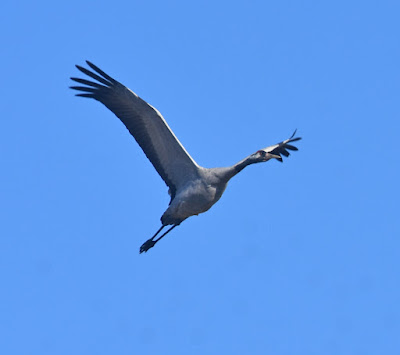
Water Rail (c) Bark
The extreme cold has yielded after a ten-day freeze
that produced night-time temperatures as low as minus eight degrees and several
days when the day-time temperatures failed to get above zero.
The next few weeks will determine what effect this has had on the bird life across Otmoor. It will be very interesting to see how birds like our Cetti’s Warblers have managed.
 |
| Frosty Robin (c) Bark |
There was one winter over ten years ago when we lost our entire population, the birds returned, but it took well over a year before we heard them back on the reserve again, and several years before the population recovered fully.
 |
| Frosted plants can be stunning (c) Bark |

Goldies just before they left
We were seeing large flocks of Golden Plover just
before the cold snap and as usually happens the birds departed once the ground
became too frozen for feeding. 
A few Snipe clung on (c) Bark
Large flocks of Lapwings also left and will
undoubtedly return as the weather recovers. Fieldfares and Redwings are still scavenging
the last of the berries from the hedgerows.
Redwing (c) Bark
 |
| Chilly Wildfowl (c) Bark |
The lagoons did not freeze over completely and a number of Mallard, Teal, Shoveller and Wigeon could be seen standing disconsonantly on the ice around the open leads of water.
 |
| Bittern (c) Trefor Knight |
Bitterns could be seen from time to time either moving between feeding areas or taking advantage of the wintery sunshine.
 |
| Bittern (c) Darrell Woods |
The Starling roost often collapses when the reedbeds freeze over, but this does not seem to have happened yet this winter.
The large numbers of Starlings continue to attract raptors, Peregrines and a single Ring-tailed Hen Harrier are often being seen along with the resident Marsh Harriers and Sparrowhawks. Red Kites patrol the edges of the reedbed every morning on the lookout for overnight casualties.
 |
| Yellowhammers (c) Bark |
We have started the winter seed feeding programme alongside the hide. It has surprised us just how rapidly the birds have found this food supply and how rapidly their numbers have increased.
 |
| Linnets can be stunning when seen well. (c) Bark |
Good numbers of Reed Buntings, Linnets and Chaffinches are predominant. However, there were at least seven Yellowhammers amongst them this weekend and the first male Brambling we have recorded this winter.
 |
| A Green Woodpecker has also been around the feeding station (c) Bark |
Otters are still being seen regularly including one
individual out of the water and walking around on the ice.
Water Rail (c) Oz
Cold weather often coaxes secretive birds out of cover
and this cold snap has been no different. A Water Rail has been feeding out in
open under the feeders in the Carpark Field. It has been interesting to see it
beside the larger, plumper Moorhens and to appreciate just how slim and delicate
it looks in comparison.
It has also been possible to see just how subtle are its colours, with beautiful slate blue flanks and its red dagger beak.

Goldfinch on Teasels (c) Darrell Woods
The Otmoor yearlist stands at one hundred and fifty-five
species, and seems unlikely to grow any more his year, although species such as
Little Owl, Ring-necked Parakeet, Grey Plover and Grey Partridge have not been
recorded this year…..there is still time!
Moonrise over the reedbed (c) Tom N.L.
























































